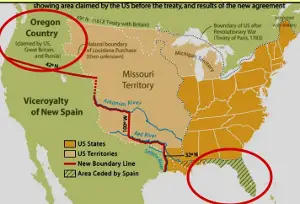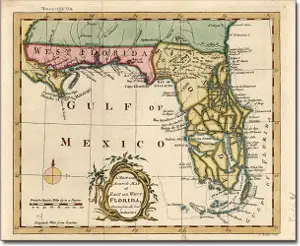The Adams-Onís Treaty was an 1819 agreement between the U.S. and Spain that transferred ownership of Florida to the U.S. and settled the border of the Texas territory.
Spain took control of Florida and ruled it until 1763, when, as a consequence of the losing the Seven Years War to Great Britain, they handed over Florida to the British. Britain divided the territory into East Florida and West Florida. Many people who lived in Florida had no sympathy for the northern colonies who declared themselves independent from Great Britain in 1776. Florida sent no delegates to the Continental Congresses. Both East Florida and West Florida remained loyal to Great Britain during the Revolutionary War. In fact, Floridians helped British soldiers conduct raids into Georgia. American forces invaded Florida twice and were soundly defeated both times. Spain took the opportunity to capture Pensacola in 1781. The end of the Revolutionary War brought Florida back into the Spanish fold; Spain and the United States agreed on the boundaries in a 1795 agreement known as Pinckney's Treaty. Andrew Jackson led a military force into West Florida in 1818 and effectively took control of the area, cementing what was shaping to be an unofficial takeover anyway because of accelerating American immigration. A revolution of sorts had occurred in 1810, with Americans in West Florida demanding to live independently of Spain. By this time, Spain was badly in need of money, having been occupied by France during the reign of Napoleon Bonaparte and also been exhausted of resources. Spanish authorities suspected that an occupation of East Florida by American settlers and/or troops was likely as well and determined to relinquish control of both Floridas while they could still get something for them. The Spanish Ambassador to the United States, Luis de Onís, entered into negotiations with then-Secretary of State John Quincy Adams for the handover of Florida to the U.S. These negotiations had actually begun before Jackson's raid into West Florida, and that raid nearly derailed the negotiations. However, Spanish authorities decided that the raid was even more proof that they wouldn't be able to hold on to Florida in the end, especially since Spanish troops to patrol the land wouldn't be arriving any time soon. Two other elements of contention between Spain and the U.S. that were discussed during these negotiations were the specifics of the boundary of what would later become the Republic of Texas and the claims of both countries on the Oregon Country. Adams and Onís eventually hammered out an agreement on these issues as well. 
The two sides eventually came to a final agreement and signed the treaty on Feb. 22, 1819. As a result, the U.S. took possession of both West Florida and East Florida, in return agreeing to pay the legal claims of American citizens against Spain, up to $5 million. The Texas and Oregon issues got folded into a quid-pro-quo, whereby the U.S. abandoned its claims to Texas west of the Sabine River and Spain gave up its claims to the Oregon Country. U.S. Government procedures stipulate that that the Senate must ratify all treaties between the U.S. and other countries, and the Senate did so, ratifying promptly and unanimously. Spain, despite urgings from Onís not to delay, did not agree to the terms of the treaty until Oct. 24, 1820. By this time, the Senate's ratification had expired and a new vote on ratification was in order. At this point, Henry Clay and others in the Senate tried to amend the treaty in order to remove the cession of American claims to Texas. The final vote went against this provision, and the treaty was finally official on Feb. 22, 1821. |
|
Social Studies for Kids
copyright 2002–2024
David White





